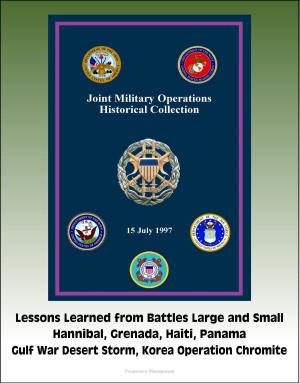DoD Nuclear Weapons Management: Task Force Reports - Air Force's Nuclear Mission and Review of DoD Nuclear Mission, Atrophy, Deterrence Policy, Modernization, Sustainment, Oversight, Inspections
Nonfiction, History, Military, Nuclear Warfare| Author: | Progressive Management | ISBN: | 9781301268085 |
| Publisher: | Progressive Management | Publication: | September 22, 2012 |
| Imprint: | Smashwords Edition | Language: | English |
| Author: | Progressive Management |
| ISBN: | 9781301268085 |
| Publisher: | Progressive Management |
| Publication: | September 22, 2012 |
| Imprint: | Smashwords Edition |
| Language: | English |
Serious incidents in 2006 (a misshipment to Taiwan of intercontinental ballistic missile [ICBM] components) and 2007 (an unauthorized weapons transfer) alerted the Department of Defense (DoD) to the Air Force's mishandling of nuclear weapons and nuclear weapons-related materiel. The ensuing investigations revealed a serious erosion of focus, expertise, mission readiness, resources, and discipline in the nuclear weapons enterprise within the Air Force. Secretary of Defense appointed this Task Force on Nuclear Weapons Management to recommend necessary improvements and measures to enhance deterrence and international confidence in the U.S. nuclear deterrent.
The Phase I Report provides independent, professional advice on our findings and our recommended improvements in Air Force organization and stewardship. Such improvements are essential both to sustain public confidence in the safety and surety of our nuclear weaponry and to bolster clear international understanding in the continuing role and credibility of the U.S. nuclear deterrent. As compared to its role in the Cold War, the nuclear mission is both different and more circumscribed. Nonetheless, it remains crucial. Other nations have substantial capabilities; some of which are growing. The number of nuclear states may be increasing—making the challenge of deterrence ever more complex. The United States provides a nuclear umbrella over roughly thirty allied countries—in NATO, the Western Pacific, and the Antipodes. The U.S. deterrent thereby remains a principal barrier to proliferation for in its absence there is little question that others would seek to create their own nuclear capabilities. Consequently, the credibility of the U.S. deterrent remains essential in maintaining international stability. It is understandable that the focus of the Air Force has been drawn to conflicts in the Gulf, the Balkans, and Afghanistan. Both inattention and conscious budget decisions have led to the atrophy of the Air Force's nuclear mission. But the balance must be restored. Though reduced in scope, the nuclear mission remains essential. The components of the nuclear mission must again become a coherent whole—and the esprit de corps of those who serve in it must be revived. The nuclear mission must be reinstituted as a continuing responsibility of the Air Force. Throughout the Cold War, the uniqueness and power of nuclear weapons were largely understood. With the end of the Cold War, and the sharply reduced likelihood of a nuclear exchange, awareness of the role and power of nuclear weapons has diminished. But their power and uniqueness endure—and must again be clearly understood if they are to play their crucial role in nuclear deterrence. Paradoxically, the goal for the nuclear deterrent is to be created—but not to be exercised in combat. If it deters attacks on the U.S., its allies, and its interest, its mission is successfully accomplished. The Air Force must make its own special contribution to the success of that mission.
Phase 2 of the Report: Executive Summary * Background * Deterrence * Understanding U.S. Deterrence Policy * The Special Case of NATO * DoD Management * OSD Organization * Nuclear Capabilities Modernization and Sustainment * Oversight and Inspections * DoD Forces * Navy * USSTRATCOM * USEUCOM/USAFE * Geographic Combatant Commands * The Joint Staff * Army * Appendix A. Tasking Letter * Appendix B. Recommendations. * Appendix C. Reference Documents. * Appendix D. Abbreviations and Acronyms
Serious incidents in 2006 (a misshipment to Taiwan of intercontinental ballistic missile [ICBM] components) and 2007 (an unauthorized weapons transfer) alerted the Department of Defense (DoD) to the Air Force's mishandling of nuclear weapons and nuclear weapons-related materiel. The ensuing investigations revealed a serious erosion of focus, expertise, mission readiness, resources, and discipline in the nuclear weapons enterprise within the Air Force. Secretary of Defense appointed this Task Force on Nuclear Weapons Management to recommend necessary improvements and measures to enhance deterrence and international confidence in the U.S. nuclear deterrent.
The Phase I Report provides independent, professional advice on our findings and our recommended improvements in Air Force organization and stewardship. Such improvements are essential both to sustain public confidence in the safety and surety of our nuclear weaponry and to bolster clear international understanding in the continuing role and credibility of the U.S. nuclear deterrent. As compared to its role in the Cold War, the nuclear mission is both different and more circumscribed. Nonetheless, it remains crucial. Other nations have substantial capabilities; some of which are growing. The number of nuclear states may be increasing—making the challenge of deterrence ever more complex. The United States provides a nuclear umbrella over roughly thirty allied countries—in NATO, the Western Pacific, and the Antipodes. The U.S. deterrent thereby remains a principal barrier to proliferation for in its absence there is little question that others would seek to create their own nuclear capabilities. Consequently, the credibility of the U.S. deterrent remains essential in maintaining international stability. It is understandable that the focus of the Air Force has been drawn to conflicts in the Gulf, the Balkans, and Afghanistan. Both inattention and conscious budget decisions have led to the atrophy of the Air Force's nuclear mission. But the balance must be restored. Though reduced in scope, the nuclear mission remains essential. The components of the nuclear mission must again become a coherent whole—and the esprit de corps of those who serve in it must be revived. The nuclear mission must be reinstituted as a continuing responsibility of the Air Force. Throughout the Cold War, the uniqueness and power of nuclear weapons were largely understood. With the end of the Cold War, and the sharply reduced likelihood of a nuclear exchange, awareness of the role and power of nuclear weapons has diminished. But their power and uniqueness endure—and must again be clearly understood if they are to play their crucial role in nuclear deterrence. Paradoxically, the goal for the nuclear deterrent is to be created—but not to be exercised in combat. If it deters attacks on the U.S., its allies, and its interest, its mission is successfully accomplished. The Air Force must make its own special contribution to the success of that mission.
Phase 2 of the Report: Executive Summary * Background * Deterrence * Understanding U.S. Deterrence Policy * The Special Case of NATO * DoD Management * OSD Organization * Nuclear Capabilities Modernization and Sustainment * Oversight and Inspections * DoD Forces * Navy * USSTRATCOM * USEUCOM/USAFE * Geographic Combatant Commands * The Joint Staff * Army * Appendix A. Tasking Letter * Appendix B. Recommendations. * Appendix C. Reference Documents. * Appendix D. Abbreviations and Acronyms















